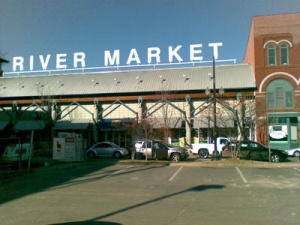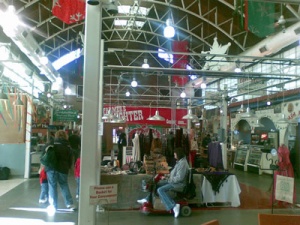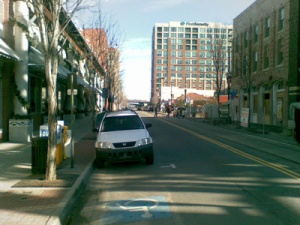Little Rock River Market District
The Little Rock River Market District is an eight-square block public food, shopping, and entertainment nexus in the heart of downtown Little Rock, Arkansas. It is one of the major cultural hubs of Little Rock, as it is home of the William J. Clinton Presidential Center, the Main Library of the Central Arkansas Library System, the Cox Creative Center, the Museum of Discovery, the Arkansas Studies Institute, Riverfest Amphitheater, Riverfront Park and the Arkansas River Trail, and a number of fine art galleries. It is also increasingly becoming a residential neighborhood for young urban professionals and empty nesters.
Contents
River Market Amenities
Ottenheimer Hall (the "River Market" building), with its indoor food vendors and outdoor farmer's market pavilion, anchors the neighborhood. Ottenheimer Hall opened in 1996 at a cost of $3.5 million. The hall features restaurants, vendor stalls, shops, free public wi-fi, and other special attractions. Ottenheimer Hall currently houses a number of vendors:
- Andina Café and Coffee Roastery
- Big on Tokyo
- Boulevard Bread Company
- Casa Manana
- Coast Café/Pie Heaven
- Cocoa Belle
- Middle Eastern Cuisine/International Pantry
- River Market Grocery
- Shaka Smoke Lodge
- Shop the Rock
The surrounding River Market District is home to a large number of restaurants:
- Boscos
- Café 42
- Farmer's Daughter Café
- The Flying Burrito
- Flying Fish
- Flying Saucer
- Gusano's
- Iriana's Pizza
- Rumba Mexi-Cuban Kitchen
- Six Bridges Bar & Grill
- Sonny Williams' Steak Room
- Sticky Fingerz
- Underground Pub
- Vermillion Water Grille
- Vino's Brewpub
The River Market District also contains a number of nightclubs, including Ernie Bigg's, Rumba's Revolution Room, and Willy D's. A large number of historic lofts and new condominium highrises have emerged in or near the River Market District:
- 300 Third Tower
- Arkansas Capital Commerce Center
- Block 2 Lofts
- River Market Tower
- Rock Street Lofts
- Tuf-Nut Lofts
Movement in the district is facilitated by the River Rail streetcar system, My Little Rickshaw, and the Downtown Navigator Program.
Annual River Market Events
The River Market District supports or is home to a large number of annual festivals and events, including:
- Arkansas Flower and Garden Show
- Arkansas Literary Festival
- Arkansas Sculpture Invitational
- Community Easter Sunrise Service
- Cruisin' in the Rock
- Jazzlights in the Park
- Light the Night
- Movies in the Park
- Riverfest
- Sandwiching in History
- Territorial Fair
History of the River Market
The River Market District occupies ground that long ago had been the main landing or public wharf along the Arkansas River. Longtime residents still occasionally call it Old Town. By the 1970s this area, rechristened the East Markham Warehouse District, was filling up with decrepit buildings. By the 1990s, remembers local developer Rett Tucker, "[T]here was a store that sold caskets, and that was about it."
The first city plan to redevelop the downtown riverfront and East Markham area emerged in the 1983 Downtown Little Rock Development Plan sponsored by planning director Nathaniel Griffin, which imagined pedestrian traffic in an area dominated by entertainment outlets and mixed-use developments. The city plan also imagined a move of the Museum of Science and History to the site of the Tenenbaum Building on Rock Street, in accord with the wishes of the board of trustees of the museum. At the same time Realty Associates of Jonesboro proposed a "central business improvement district" bounded by the Arkansas River, Commerce Street, Sherman Street, and Fourth Street where tax free development bonds would reenergize the Sherman Oaks condominium project, and the refurbishing of the Terminal Building. Little Rock city director Webster Hubbell proposed a new multiuse arena on East Markham and B. Finley Vinson wanted a parking garage built between the Main Street and Scott Street ramps to the Main Street Bridge at about the same time.
The River Market Hall concept was the brainchild of Little Rock developer Jimmy Moses, who conceived the market hall in the early 1980s following a visit to the Pike Place Market in Seattle, Washington, and of a local grassroots coalition of citizens, business owners, government officials, and bankers organized into the public-private Downtown Little Rock Partnership. In 1983 Moses called East Markham "one of the most valuable pieces of real estate in Little Rock" because it was "on the water, kind of like our bay" and could be redeveloped into "a real neighborhood" with "specialty niche" boutiques, retailers, and restaurants. Plans for the revitalized district were incorporated into the $42.1 million Project 2000 plan put before local citizens in October 1991, but it failed by a margin of 57 to 43 percent.
The $3.5 million market complex was eventually approved by taxpayers as part of the sweeping 1995 River Project to mitigate the economic effects of decrepit warehouse and industrial brownfield areas along both the north and south banks of the Arkansas River, expand the Statehouse Convention Center along Markham Street, and build ALLTEL Arena in North Little Rock.
The River Market Task Force that guided completion of the River Market part of the River Project was spearheaded by city director Dean Kumpuris. In 1995 Kumpuris called the project "a prime example of the way our city can accomplish great things when we work together." The market district part of the River Project collected more than $5 million, including $1.2 million in federal funds, $1.1 from the Capitol Improvement Bond Fund, $200,000 from city street department coffers, $170,000 from the Downtown Little Rock Partnership, $100,000 from Riverfest promotional events, and $80,000 from the Central Arkansas Library System.
Ottenheimer Market Hall opened at 400 East Markham Street (now President Clinton Avenue) in July 1996, and is operated by the Downtown Partnership from the second floor of adjoining Dickinson Hall. Both halls were designed/refurbished by Rick Redden of AMR Architects.
Economic Impact
In total about $1 billion of direct investment accrued to the River Market District between 1997 — when the city was selected over Hope, Fayetteville, and Hot Springs as the site of the Clinton Presidential Center — and 2004 when the Clinton Library dedication ceremony took place. Said Little Rock City Manager Bruce Moore in 2004, "The presidential library has had a tremendous impact on our central core. It has totally revitalized downtown." Between 1998 and 2003 property values in the River Market area doubled on the expectation of $10.7 million in additional annual revenue.
Continued economic development in the River Market District is spearheaded by Metrocentre Improvement District commissioners.
References
- Margaret Arnold, "Revival of LR Riverfront Fosters Optimism About New Prospects," Arkansas Democrat-Gazette, May 22, 1983.
- Kyle Brazzel, "James A. Moses: Success Finally Came Downtown for Jimmy," Arkansas Democrat-Gazette, October 21, 2001.
- Kyle Brazzel, "Taking Stock of the Market," Arkansas Democrat-Gazette, June 30, 2006.
- "Clinton Library Jump-Starts Downtown Little Rock," American Libraries, 34.2 (February 2003): 23.
- Larry Copeland, "City Takes Cue from Comeback Kid: Clinton Library Breathes Life into Struggling Little Rock," USA Today, October 8, 2004.
- Leroy Donald, "Excitement of Developers Builds Downtown, Along River Front," Arkansas Gazette, June 5, 1983.
- Michele Norris and Greg Allen, "Building Boom Around Clinton Presidential Center and Park in Little Rock, Arkansas," NPR News: All Things Considered, June 14, 2001.
- Noel E. Oman, "Officials Plan to Revisit Oregon: Follow-up to '95 Portland Trip Will Focus on Growth in Transit," Arkansas Democrat-Gazette, July 25, 2005.
- Mark Oswald, "River Development Ideas Include High-Rise, Museum," Arkansas Gazette, June 1, 1983.
- "Presidential Center Revitalizes Little Rock," American City & County 113.10 (September 1998): 106.
- Bill Worthen, "Pedestrians Downtown with a Sports Arena," Arkansas Gazette, April 12, 1983.



